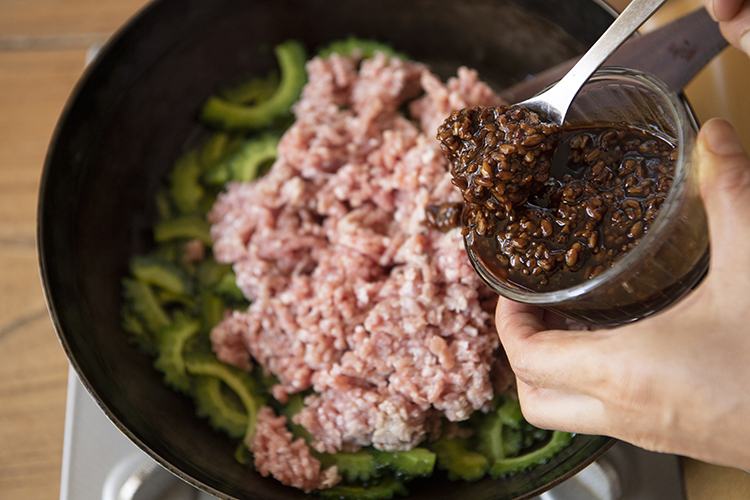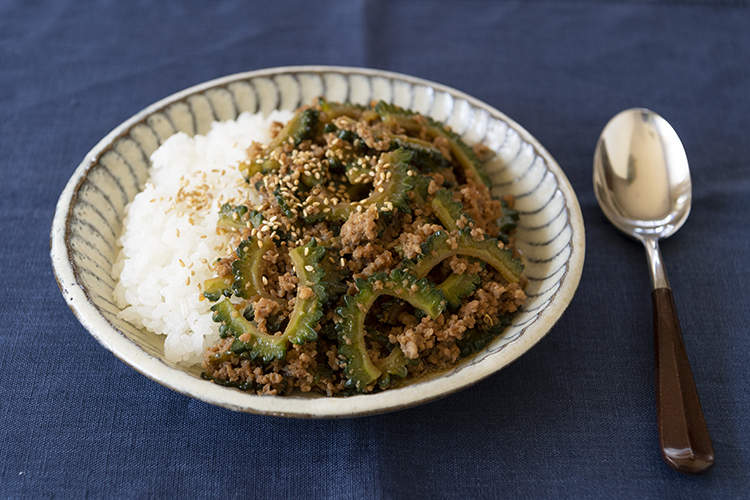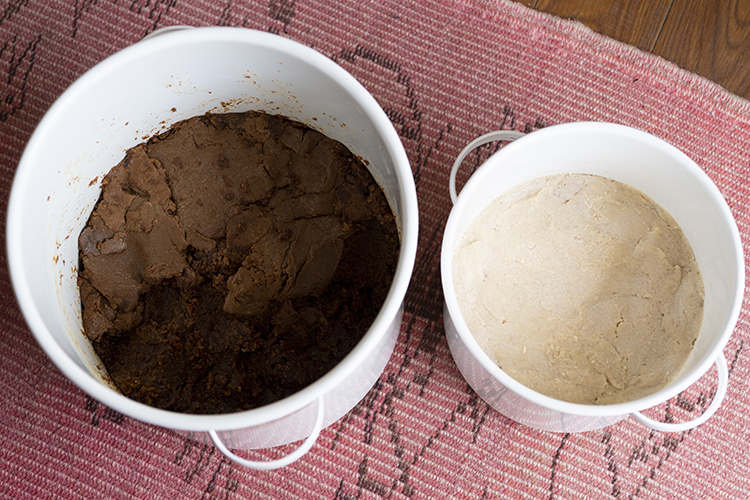Soy Sauce Koji Recipes by Kikkawa Toshiye
Jun 22,2023
Soy Sauce Koji Recipes by Kikkawa Toshiye
Jun 22,2023


Summer is sweaty season, and it’s all too easy to feel out of sorts. No matter how busy you are, it’s important to eat a nutritionally balanced diet. That’s where meal prep comes in.
We’ve therefore turned to culinary expert and qualified fermented foods specialist Kikawada Toshie for advice. Here she explains how to make soboro minced pork and bitter melon flavored with shoyu koji—rice malt mixed with soy sauce. Bitter melon is a highly nutritious summer vegetable, and shoyu koji is a fermented food possessing a delightfully mellow umami flavor. Toshie also tells us how to prepare shoyu koji, which she loves. Further, she talks about the joy of fermented foods. She got her rice-bran pickling bed from her mother, she says, and makes her own miso by hand.
Toshie first learned of shoyu koji, she says, as a result of the salted koji craze that started a decade ago.
“When I tried using it, I was really taken with the flavor. It’s mellower than plain soy sauce, and it has a noticeably full-bodied umami and sweetness. Plus it’s all you need to achieve the flavor you want. There’s no need to add individual condiments like soy sauce or mirin (sweetened sake) or sugar. As someone making meals for my family every day while working and being a parent, I thought it would be crazy not to use it.”
Toshie doesn’t just use shoyu koji. She now makes it herself as well. “Simply soak koji in soy sauce and it’s ready. Even if you’re constantly on the go, it’s easy to try making.”
One thing Toshie often makes using shoyu koji is soboro or seasoned minced meat, which can be kept to eat later in the week. For us she prepared a summer version with bitter melon added, which often appears on the Kikawada family dining table during summer. “This vegetable is highly nutritious, so ever since my children were little, I’ve ensured they eat plenty of it by being creative in the kitchen.”

What many people don’t like about bitter melon is, well, the bitter taste.
“Yet bitter melon goes well with the full-bodied flavor of shoyu koji and the umami of meat. So when it’s put in soboro minced pork, the bitterness blends in nicely and becomes something to savor. It’s common practice to boil bitter melon or rub it with salt to alleviate the bitterness, but you don’t even have to do that.”
The secret to making this dish taste delicious is to add shoyu koji at the same time, before you start frying the meat. “Slowly stir-frying the meat so it absorbs the shoyu koji helps the soboro become infused with flavor.”


The only seasonings used are shoyu koji, sake, and salt. Toshie uses homemade shoyu koji, though of course you can use the store-bought variety instead.
1.Cut the bitter melon lengthwise in half and remove the pith. Cut into thin slices.

The pith can easily be scooped out with a small spoon. Don’t worry about being too thorough, since the bitterness won’t be too noticeable anyway.
3.Once the bitter melon becomes soft, turn off the heat and add the minced pork and the two seasoning ingredients. Fry for 4-5 minutes over medium-low heat while stirring with a wooden spatula.


Turn off the heat once the rinds of the melon become translucent and soft (left). Then add the shoyu koji at the same time as the minced pork (right). Slowly stir-fry so that the flavor thoroughly infuses the soboro mixture.
NOTE: This dish will keep for 3 days in the fridge and 2 weeks in the freezer.


“I use rice koji in granular form,” says Toshie. “I quickly mix together the koji with clean hands to promote fermentation with the resident bacteria on my hands. When using koji in a slab, crumble it first.” Toshie’s favorite rice koji is that made by Mitsuru Shoyu in Itoshima, Fukuoka.
It’s really handy to have this soboro minced pork in your fridge, Toshie says.
“Just pour it over rice, or over noodles like udon, and you can get protein, summer vegetables, and carbohydrates all in one go. It lets you easily make a nutritionally balanced meal, all on a single plate. It’s a godsend on a hectic day.”
What’s more, it has a well-defined flavor, so it also tastes good cold, making it the perfect bento boxed lunch item or salad topping. With the hot days of summer just around the corner, this dish appears poised to make waves as a big timesaver in the kitchen.

Serve on rice and sprinkle with toasted sesame seeds to the perfect lunch or dinner. It’s wonderfully filling.
Toshie became certified as a fermented foods specialist seven years ago.
“Fermented foods were something I just took for granted as part of my daily meals. I knew almost nothing about them. But I was eager to learn more. I wanted to consider my family’s health. I wanted to choose great-tasting seasonings to use every day. I wanted to convey the magic of fermented foods in my nutrition classes.

Toshie makes all manner of fermented foods at home to serve at mealtimes. Rice-bran pickles are a case in point. “My mother shared some of her rice-bran pickling bed with me. I’ve been eating pickles made in it since I was a child, and my kids love their grandmother’s pickles, so I wanted the pickles I made at home to taste the same.”
But mysteriously, her pickles never turn out the same as her mother’s. “Even my kids say that. Maybe it’s because of the different environment in which the pickling bed has been nurtured. There’s a lot more to a pickling bed than meets the eye.”
It’s a matter of trial of error, she finds, and she’s had many false starts.
“When we’re going to be away from home, say, I’ve often put the pickling bed in the fridge to slow down the fermentation process, only to flub it. My mother always keeps her pickling bed at room temperature, yet strange to say, she never spoils it. When she’s going to be away, she removes the moisture, then sprinkles the surface with salt and gives the bed a light mix, thus increasing its salinity. And that’s it. I’ve taken a page out of her book and basically keep my bed at room temperature as well.”

Toshie makes her pickles in an enamel container. “It looks sleek and doesn’t get in the way in the kitchen.”
Miso is another fermented food Toshie loves making at home. “I use twice as much koji as soybeans, because using plenty of koji gives the miso a sweeter taste that makes it go down more easily. I’ll sometimes make miso with rice koji combined with barley malt. It’s more fragrant than miso made with rice koji alone, and it tastes delicious.”
She prepares a five-kilo batch for fermentation twice a year before the onset of winter and summer. “I got into this cycle because it lets you enjoy the taste of young miso—miso that isn’t overaged.”
Sake lees play a key role in the miso aging process. “They contain alcohol, so you can prevent mold by placing sheets of sake lees on the miso after preparing it for fermentation, then putting on the lid. What’s more, the sake lees absorb the tamari—the thick liquid that accumulates on the surface as the miso ages—during the maturation process. They make for a tasty extra. They can be eaten as a snack with a drink or used to make a marinade for fish or meat.”

Last year’s miso (left) and this year’s miso (right).
The white sake lees have turned brown from absorbing the tamari liquid. After aging, the miso can be stored with the surface still covered in sake lees if it isn’t to be used yet.

Culinary expert, food stylist, and fermented foods specialist
The mother of two children, Kikawada Toshie educates children about nutrition and runs the family workshop “tottorante.” She also studies athletic nutrition based on her experience providing dietary support to her husband, a former professional soccer player in the Japanese leagues, and her daughter, a high school athlete. Among other books, she is the author of 100 Delicious Meal Recipes You Can Make on a Hot Plate (published by Shufu no Tomo Sha).
https://www.instagram.com/tottokikawada